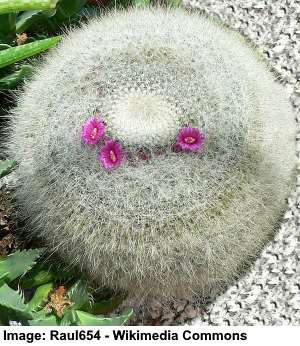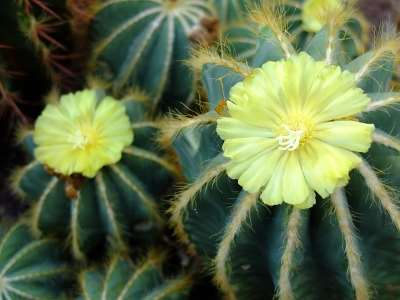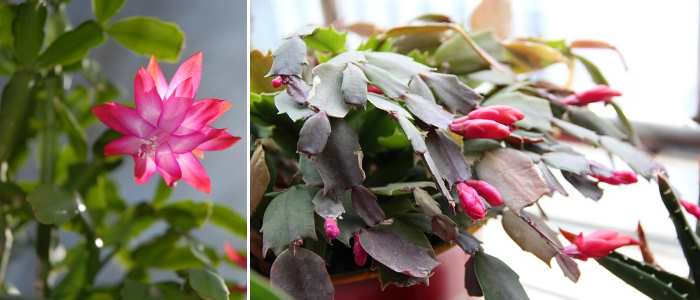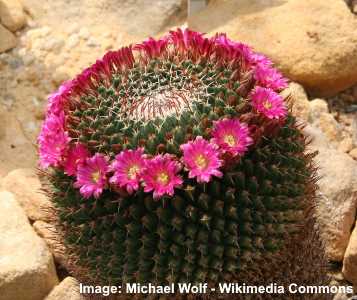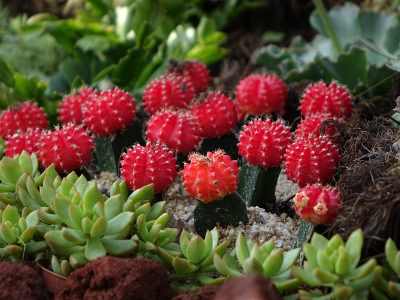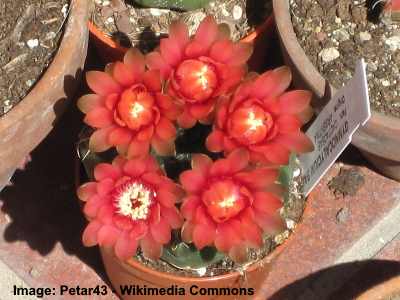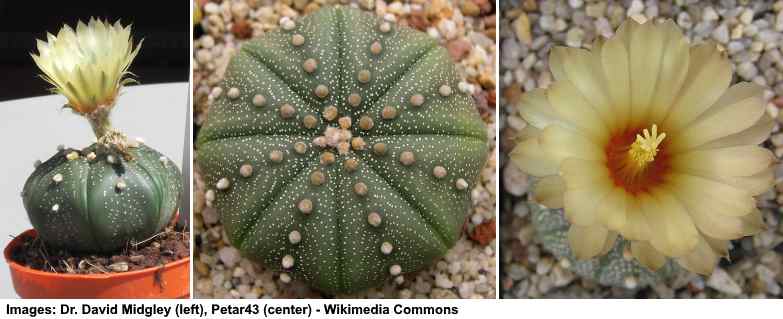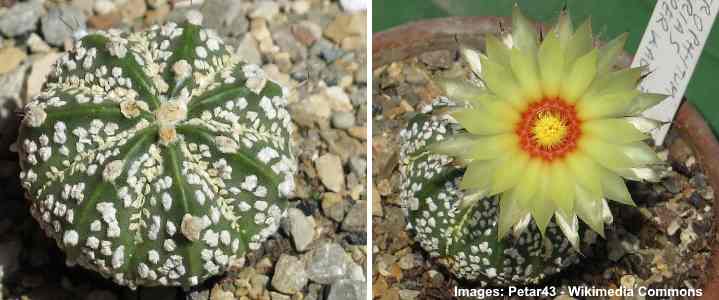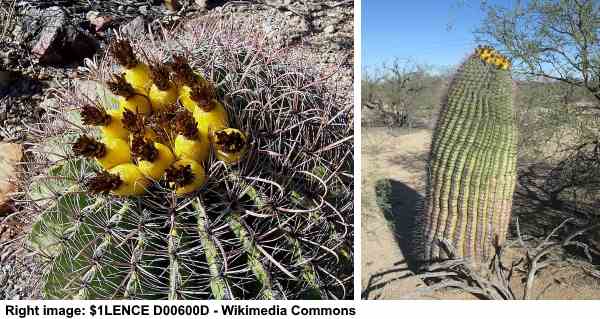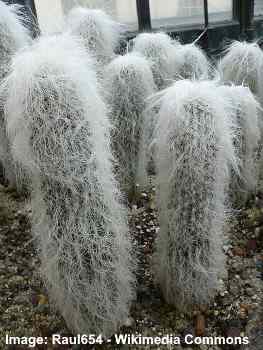74 Types of Cactus With Pictures – Identification Guide (Indoors and Outdoors)

Many types of cactus plants are easy to grow and care for and can make great houseplants. There is a wide variety of cacti to choose from if you want to grow this type of plant. Cacti come in all shapes, sizes, and colors, and some house cacti look stunning when they flower. Lots of different types of cacti also thrive outdoors where the climate is hot and dry. Some cactus species also thrive in tropical climates where they require a warm humid environment.
Caring For Different Types of Cacti
One of the great things about having different types of cacti as houseplants is that they need little watering. The majority of indoor cactus plants should be planted in small pots placed on sunny window sills and watered occasionally. Popular indoor varieties of cacti include Bunny Ears, Christmas cactus, Moon cactus, and the Balloon cactus.
Of course, cacti are well-known for growing outdoors in arid deserts. If you live in a warm climate, planting different kinds of cacti can decorate your garden or rock garden. Some good choices of desert cactus types for growing outside are the Arizona Barrel Cactus, the Prickly Pear, and the Old Man Cactus.
Cactus Plant Features
The cactus plant family (Cactaceae) consists of a number of unique succulent-type plants that thrive in dry conditions. There are thousands of different types of cacti, with all of them being native to the Americas.
Unlike many other types of succulents that store moisture in their leaves, cacti are specially adapted to retain water within their stems. This adaptation allows them to survive in environments where water is scarce. Most cactus varieties exhibit green stems, which perform the dual functions of photosynthesis and water storage.
A remarkable aspect of cacti is their method of photosynthesis. Cacti utilize a water-efficient process known as Crassulacean Acid Metabolism (CAM), where they absorb carbon dioxide at night when temperatures are cooler. This adaptation minimizes water loss during the hot daytime by keeping the stomata (tiny openings in the skin) closed during daylight hours.
Many desert cacti have evolved stems with ribs or pleats that allow them to expand during periods of rainfall, absorbing and storing water. This capability enables them to withstand long periods of drought.
Another of the identifying features of cacti is their spines.
The spines serve several functions, including deterring herbivores, providing shade, and reducing airflow to minimize water loss. While some cacti have sharp spines capable of causing injury, others have softer, hair-like spines that offer protection without the risk of harm.
Cactus Flowers
One of the most captivating features of cacti is their blossoms. Despite their rugged, water-conserving nature, cacti produce flowers that are often strikingly beautiful and vibrant. These blooms can exhibit a wide range of colors, including deep pinks, bright reds, sunny yellows, oranges, pristine whites, and rich burgundies.
Cacti are indeed a subgroup within the larger category of succulents, and while all succulents have the potential to flower, cacti are particularly noted for their spectacular blooms. The flowering of cacti is not just a differentiation from other succulents but a highlight of their lifecycle, attracting pollinators and contributing to the ecosystem.
The blooming period of cacti is usually short-lived, but the flowers make a significant visual impact. Each species of cactus has its own specific flowering time, which can sometimes be used as an identifying feature. The variety in the timing and appearance of flowers among cactus species adds to the intrigue and desirability of cultivating these plants.
Understanding that all cacti are succulents but not all succulents are cacti is crucial. The key distinction lies in their flowering characteristics and their specialized adaptations for surviving in arid environments. This makes the flowering of cacti not only a delightful spectacle but also a testament to their resilience and adaptation.
How to Identify Cactus Varieties
Identifying cactus species involves a careful examination of their unique characteristics, such as shape, size, spines or hairs, and flowering patterns. The form of a cactus—ranging from spherical to columnar, cylindrical, or flat paddles—is a primary indicator of its species.
Additionally, areoles, the small cushion-like spots on cacti from which spines, hairs, and flowers emerge, serve as a distinctive feature of these plants.
The nature of the spines or hairs, whether they are long and sharp to deter predators or soft and insulating, along with the arrangement and density, can significantly aid in identification. Furthermore, the vibrant and varied flowers of cacti, which differ in size, color, and blooming season, provide critical clues to the species’ identity.
Environmental context and growth habits also play crucial roles in identifying cactus varieties. For example, cacti adapted to desert conditions exhibit specific water-conserving features, while those from tropical regions may have different characteristics
Types of Cactus (With Pictures and Names) – Identification Guide
So now that you know that cacti are flowering plants that are easy to care for, let’s look at many types of cacti for growing indoors and outdoors.
Bunny Ears Cactus (Opuntia microdasys)
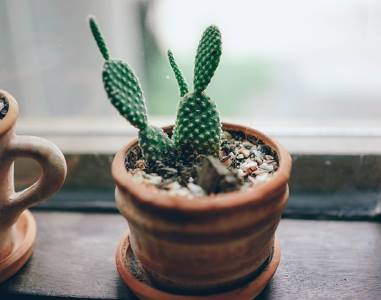
The Bunny Ears is a flowering type of cactus which resembles rabbit’s ears. The small size of this cactus makes it a perfect house plant.
Bunny Ears cactus is a flowering type of cactus native to Mexico that grows indoors just as well as it grows outdoors. Other names for this interesting bunny ears cactus include Bunny cactus, Angel’s Wings, or Polka-Dot cactus.
The Bunny Ears cactus is a houseplant that looks comical with its green pads that resemble rabbit’s ears. The indoor cactus can grow around 15” to 23” (40 – 60 cm) tall. However, as with most cacti, the Bunny Ears cactus is slow-growing and a small type of plant will take a few years to reach this height.
Occasionally, you may see yellow flowers blooming on the Bunny Ears.
The Bunny Ears cactus has fine hair-like spines (glochids) that are extremely thin. They can cause a great deal of skin irritation if you brush against the plant and they lodge in your skin. The white or yellow glochids give the plant a dotted appearance like polka dots.
Did you know that one of the best ways to remove cactus glochids is by using sticky tape to pull out the fine hairs?
Cactus Identification: The Bunny Ears cactus is identified by its flat, disc-shaped stems covered in small tufts of fine hairs. This cactus can be easily identified due to the characteristic look of a rabbit’s ears.
Old Lady Cactus (Mammillaria hahniana)
The Old Lady Cactus is a sizable, spherical cactus covered in spikes and fine spines, much like a large pincushion. This ball-shaped cactus can grow up to 20 inches (50 cm) in diameter and 10 inches (25 cm) tall. Among its charming features are the reddish-purple flowers that emerge in a circle around the cactus’s top, usually from late winter to early spring. It requires a hot, dry climate to flourish and is commonly grown indoors in a large container.
Cactus Identification: The Old Lady cactus has an identifiable globe-like shape covered in fine white fuzzy spines giving the round cactus a furry appearance. Another trait of this globular cactus is its papery purple flowers that bloom on the cactus flattened top.
Balloon Cactus (Parodia magnifica)
This large cactus, the Balloon cactus, certainly lives up to its scientific name, the Parodia magnifica – Many describe the appearance of this round cactus as magnificent.
The stunning large globe-shaped Balloon cactus has a large rib-like appearance with rows of contrasting white or yellow spines on the edge. Another striking feature of this large cactus is the large yellow flower that appears on the top when it blooms.
The Balloon Cactus can grow up to 6” (15 cm) tall and measure 18” (45 cm) across.
Cactus Identification: The Balloon cactus has recognizable ridges down the side of the rounded green plant. Each ridge has characteristic fine yellowish spines and a yellow flower blooms on the cactus top.
Christmas Cactus (Schlumbergera)
A very popular indoor type of cactus is the Christmas cactus that is native to tropical regions in Brazil.
There are actually a number of types of cacti in the Schlumbergera family, with the Christmas cactus being just one. This type of cactus doesn’t have leaves but long trailing flat segmented stems. This cactus species flowers during winter time, which is why it is called the Christmas cactus.
The trailing flowering stems make this cactus variety a good option for hanging baskets or to place on top of furniture.
This flowering cactus species can produce white, pink, yellow, and red flowers.
Different species of cacti in the Schlumbergera genus flower at different times of the year. Some other similar types of cacti include the Easter cactus (a cactus now in the classification of the genus Hatiora), Thanksgiving cactus, or Holiday cactus.
To ensure the Christmas cactus flowers, it needs to be in cool conditions with little water and get 12 – 14 hours of darkness every day.
Cactus Identification: The identifying trait of the Christmas cactus is the flattened rectangular green leaf-like leaves with scalloped edges. The segmented succulent “leaves” can grow 6” to 12” (15 – 30 cm) long and up to 24” (60 cm) wide.
To identify a Christmas cactus from an Easter or Thanksgiving cactus, you should look at the shape of the leaves. The Easter cactus is identified by its rounded leaves with scalloped margins and soft hairs. The Thanksgiving cactus has flattened leaves with pointed or spiked margins.
Thanksgiving Cactus (Schlumbergera truncata)

The Thanksgiving cactus is most commonly recognized as a succulent houseplant with flat green stems and vibrant tubular flowers. This epiphytic cactus has trailing stems divided into segments with claw-like projections on the margins. It blooms in late November with pink, red, purple, yellow, or white flowers.
Also called the crab claw cactus, the cactus succulent stems grow up to 12” (30 cm) long and spread 24” (60 cm) wide. It’s a beautiful indoor hanging basket plant for adding height and color late in the season. The cactus requires cool nights, high humidity, and at least 12 hours of darkness for six weeks to encourage blooming.
Powder Puff Cactus (Mammillaria)
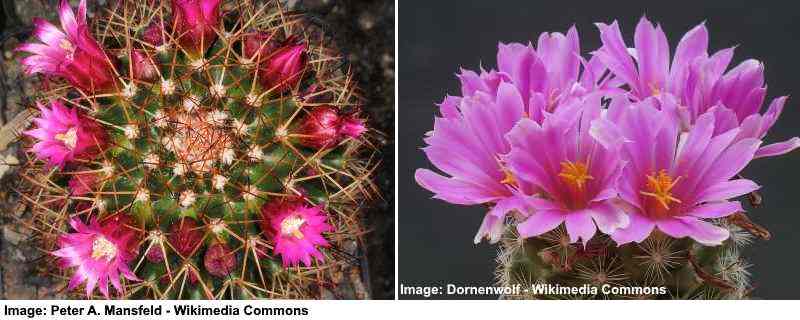
The Mammillaria family of cacti includes several cultivars: Mammillaria backebergiana ernestii (left) and Mammillaria boolii (right)
The Powder Puff cactus is a small round cactus that is a species in the Mammillaria family of cacti.
The Powder Puff cactus is shaped like a ball and it is a slow-growing variety of cactus which is surrounded by soft hairy spines. From the various cacti in the Mammillaria family, the Powder Puff cactus is one of the easiest to care for. The spherical cactus will grow to between 3” and 5” (7.5 – 12 cm) high and about the same in diameter.
As with most cacti, the Powder Puff cactus needs to get a lot of sun, and the soil should never be more than slightly moist. You can expect the Powder Puff to bloom in the summertime with white or red flowers that form a crown on the top.
Other popular cacti from the Mammillaria genius include some of the following:
Mammillaria backebergiana ernestii is a cactus that has a tall cylindrical appearance.
Mammillaria boolii is a small round cactus covered in fine hair-like spines. The interesting feature of this cactus is the relatively large flowers which appear on this small cactus.
Mammillaria mystax is native to Mexico and has reddish-violet flowers that appear in April and May.
Cactus Identification: The identifiable traits of the Powder Puff cactus are its rounded, ball shape covered in clumps of sharp spines. When in bloom, the stunning flowering plant has a ring of purple, pink, or white flowers creating a beautiful crown.
Lady Finger Cactus (Mammillaria elongata)
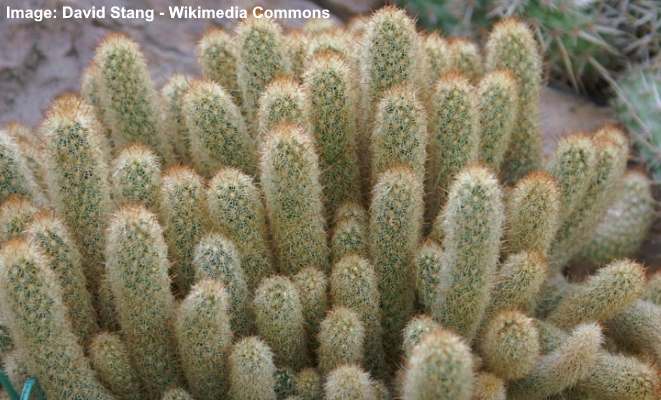
Lady Finger cactus is identified by its dense groups of woolly golden cylindrical stems
The Lady Finger cactus is a small cactus plant with stubby columnar stems covered in sharp fuzzy spikes. The cylindrical green stems have a yellow or white appearance due to the sharp spikes. The erect cactus stems grow 2.3” to 6” (6 – 15 cm) long and up to 1.6” (4 cm) in diameter.
Like all cactus plants, the Lady Finger cactus produces flowers on the stems’ upper parts. The flowers have pale yellow or white petals and appear amongst the woolly areoles. The densely clumping yellowish-green cactus blooms from late winter through early summer.
Cactus identification: The Lady Finger cactus has identifiable cylindrical stems with tufts of woolly areoles, short yellowish spikes in radial patterns, and pale-yellow flowers.
Feather Cactus (Mammillaria plumosa)
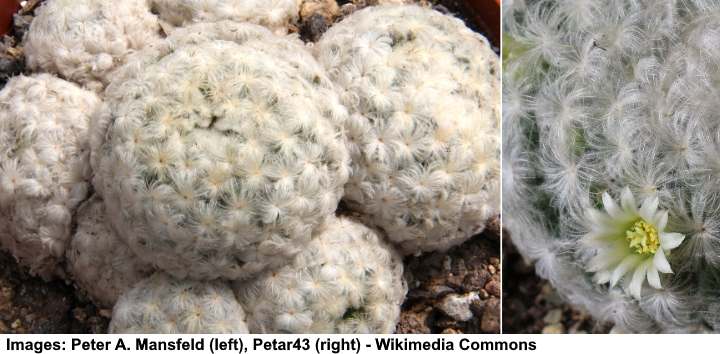
The Feather cactus has rounded woolly shape with white flowers
The Feather cactus looks like a fluffy rounded ball of white cotton wool. The clumps of globular stems are covered with a woolly, white downy substance giving the cactus a soft appearance. However, the soft feathery covering hides sharp spikes that cover the flowering cactus.
Each of the spherical cactus stems grows around 3” (7 cm) in diameter. Like many cacti in the genus Mammillaria, a soft, feathery, downy substance and jagged spikes cover the plant. Additionally, the spiked cactus blooms with white flowers that have hints of pink and yellow.
Cactus identification: The feather cactus is easy to identify due to its cotton wool-like covering, spherical shape, and spiny surface.
Spiny Pincushion Cactus (Mammillaria spinosissima var. ‘Rubrispina’)
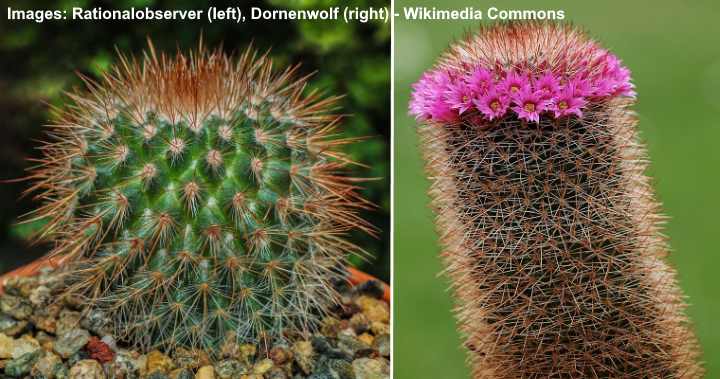
Spiny Pincushion Cactus ‘Super Red’ (Mammillaria spinosissima var. ‘Rubrispina’)
The spiny pincushion cactus is a cylindrical or spherical cactus with reddish spikes. The small ball-like spiky cactus grows up to 12” (30 cm) tall and 4” (10 cm) wide. However, the slow-growing cactus has minimal growth in small pots indoors. When blooming, the spiny pincushion cactus produces funnel-shaped pink flowers.
Cactus identification: The ‘Super Red’ spiny pincushion cactus has identifiable bright red-orange spikes that contrast with the green surface of this bumpy spherical cactus.
Moon Cactus (Gymnocalycium mihanovichii)
Originating in Paraguay and Argentina, the Moon cactus is an unusual type of cactus with a colorful top that can be red, pink, orange or yellow.
Moon cactus lacks chlorophyll, rendering it incapable of surviving on its own. Therefore, it is grafted onto a chlorophyll-producing succulent base, enabling it to thrive. Usually, Commonly available as a pre-grafted plant, the Moon cactus is distinguished by its bright, spiky crown perched upon a columnar succulent. These cacti prefer indirect light or partial shade and require watering only when the soil completely dries out, with a pause in watering during the winter months for optimal care.
These colorful cacti varieties come in vibrant pink, orange, red, and yellow colors. Unlike other types of indoor cacti, these houseplants prefer partial shade. You should also water the cactus well every time the soil dries out. Avoid watering during the winter.
Cactus Identification: A Moon cactus is easy to recognize thanks to the colorful ribbed ball sitting on top of a columnar, three-sided cactus.
Further reading: Moon Cactus Care and Growing Guide.
Chin Cactus (Gymnocalycium)
The Chin cactus originates in South America and is a small round type of indoor cactus.
Originating from South America, the Chin cactus, or Gymnocalycium, is a small, globular cactus known for its bright and sizable flowers.
The genus name Gymnocalycium, meaning “naked calyx,” refers to the flower’s structure, which is typically devoid of spines or hair, contrasting with the misconception of it being a “spineless” cactus. Within this genus, approximately 70 species exist, each producing vividly colored flowers in shades of red, white, or pink. Size varies among the species, ranging from compact cacti just 1.5 inches (4 cm) in diameter to larger varieties up to 6 inches (15 cm) across.
Cactus Identification: Recognizable by their spherical shape and the presence of colorful blooms, Chin cacti may feature either soft or sharp spines along their ridges, contrary to the “spineless” misnomer. Their notable round form and the significant, vibrant flowers they produce are key identifying characteristics.
Star Cactus (Astrophytum asterias)
Native to Texas, the Star cactus is a small round cactus that is also known as the starfish or sea urchin cactus because of its shape.
The Star cactus has the shape of a puffed-up disc and its body is divided into sections. On each of the segments are rows of white dots that are covered with tiny hairs. The cactus should flower in the springtime with a large yellow flower on its top.
Because this type of cactus is a popular houseplant, many cultivars have been developed. Some of these, such as the Astrophytum asterias ‘Super Kabuto’ is a delightful ornamental cactus with patterns of interesting white dots covering the body.
Cactus Identification: The Star cactus is a green cactus with a smooth round, bulging shape, covered in white dots, fine hairs, and a line of raised tufts along the center of each segment. This “non-prickly” cactus has identifiable pale-yellow blooms that appear in spring.
Fairy Castle Cactus (Acanthocereus Tetragonus)

The Fairy Castle cactus is a common indoor cactus with columnar erect stems and new buds that look like castle’s turrets
The Fairy Castle Cactus is a tall, columnar cactus with long dark green angular spiny stems. The cactus stems may have three to five ridges, each containing tufts of six to eight sharp spikes up 1.6” (4 cm) long. Fairy Castle cactus blooms are greenish-white flowers.
The name Fairy Castle or Fairytale Castle cactus comes from the curved stems growing on the main stems. This feature gives the cactus the appearance of a castle’s turrets. The unique shape of the Fairy castle cactus makes it a popular ornamental houseplant.
Cactus identification: The Fairy Castle cactus is identified by its long green spiky stems, small side growths on the stems, and whitish flowers that may turn pale orange when blooming. The cactus can grow up to 6 ft. (1.8 m) tall.
Bishop’s Cap Cactus (Astrophytum myriostigma)
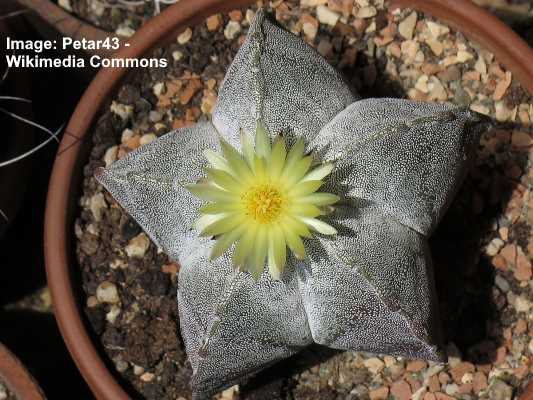
The Bishop’s Cap cactus has yellow or white flowers and gray-green star-shaped ribs
The Bishop’s Cap cactus is a spineless, spherical cactus with three to seven prominent vertical ribs. From above, the cactus has a star shape. From the side, the cactus has the appearance of a bishop’s hat. The Bishop’s Cap cactus blooms in spring with yellow or white flowers.
Also called the bishop’s hat or bishop’s miter cactus, the star-shaped cactus has a grayish-green color. In the wild, the spherical cactus can grow up to 3 ft. (1 m) tall and 8” (20 cm) in diameter. However, as a houseplant, the slow-growing cactus stays as a small star cactus plant.
Cactus identification: The Bishop’s Cap cactus looks like a bulging star, typically with five pronounced vertical ribs and a bluish-green or grayish-green appearance.
Star Rock Cactus (Ariocarpus kotschoubeyanus)
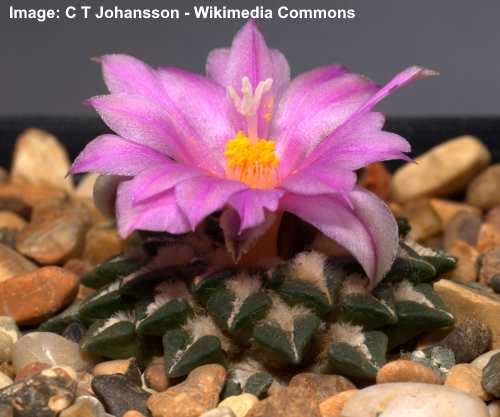
The Star Rock cactus has pink flowers and triangular stems in a disc shape
The Ariocarpus kotschoubeyanus cactus is an unusual desert plant that looks like a thick, flattened disc made up of pointed stems. The triangular tubercles (stems) point outward around the perimeter of the cactus, and it has a flat, woolly top. When blooming, vibrantly colored pink flowers appear on the top.
The Ariocarpus kotschoubeyanus grows up to 3” (7.5 cm) in diameter. The flowers of this small star-shaped cactus grow up to 1” (2.5 cm) in diameter. Due to its gravel-like appearance, the cactus is also called the living rock cactus.
Cactus identification: The Star Rock cactus has identifiable pointed triangular stems forming a disc-shaped cactus.
Crown Cactus (Rebutia marsoneri)

The Crown Cactus has small rounded stems with red, pink, yellow or orange flowers
The Crown Cactus is a small, slow-growing flowering cactus with ball-shaped stems measuring 3 inches (7.5 cm) in diameter. The bumpy surface of the cactus is covered in tufts of flexible, light brown, or white spines. This globular cactus plant produces showy yellow, orange, pink, or red flowers from its base.
The flowering spherical cactus has clumping growth. The small cactus spheres form larger clusters. The Crown Cactus is one of the first cacti to blossom in spring. The small round cactus also has the botanical name Rebutia minuscula.
Cactus identification: The Crown Cactus is a small globe-like cactus with white or tan-colored spiny tufts covering its bumpy surface.
Eriosyce Cactus (Eriosyce senilis)
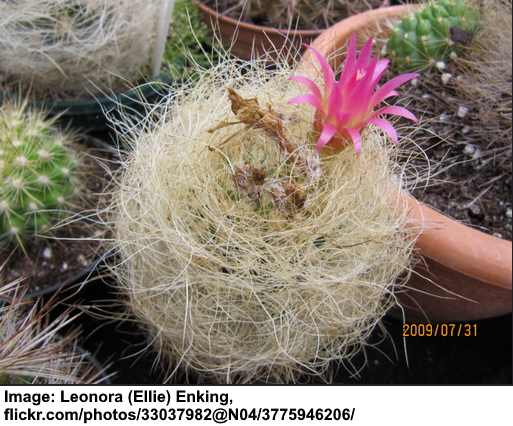
Eriosyce cactus is a small rounded fuzzy cactus with pink flowers
One of the most fascinating fuzzy cactus plants is the Eriosyce plant. This cylindrical cactus has a barrel shape, covered with twisting feathery spines. When in bloom, bright pink flowers emerge from the fuzzy top. The small fuzzy cacti thrive in small pots indoors and perform best in a warm, dry atmosphere with plenty of sunlight.
Cactus identification: The Eriosyce cactus is easy to recognize because it looks like the small round cactus is wrapped in woolly spines or hay. Some species of Eriosyce cacti have multi-colored spines decorating the cactus.
Rat’s Tail Cactus (Aporocactus flagelliformis)
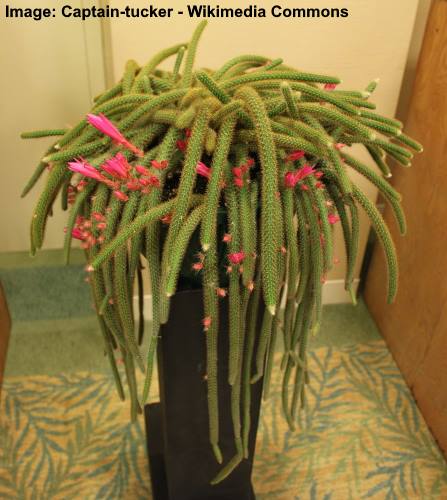
The Rat’s Tail cactus is a great plant for hanging baskets due to its drooping cylindrical stems
The Rat’s Tail Cactus is a flowering succulent plant with long, drooping cylindrical stems that grow up to 6.5 ft. (2 m) long. The slender tube-like round “tails” are covered in tufts of tan spikes and fuzzy white hairs. When in bloom, the Rat’s Tail cactus produces showy crimson-pink funnel-like flowers.
Due to its colorful blooms and long dangling succulent stems, the Rat’s Tail cactus is one of the most spectacular cacti for hanging baskets. The cascading tuberculate stems and colorful flowers make for an eye-catching display.
Other names for the Rat’s Tail Cactus are Whip Cactus and Rattail Cactus.
Cactus identification: The Rat’s Tail Cactus is easy to identify due to the 3 to 6 feet (1 – 2 m) long spiky tubular stems and spectacular floral displays of bright pink flowers.
Silver Ball Cactus (Notocactus scopa)

The Silver Ball cactus has rounded/cylindrical fuzzy shape and beautiful yellow flowers
The Silver Ball Cactus is a small round cactus with white tufts, yellowish-brown spines, and a woolly crown. The round spherical cactus grows 2” to 20” (5 – 50 cm) tall and 4” (10 cm) wide. The top of the cactus produces brightly colored yellow flowers that have a red center. This round cactus with long spines is a beautiful houseplant that thrives in full sun.
Cactus identification: The silver ball cactus is identified by its yellow blooms on this spherical green cactus with a yellowish, spiny appearance.
Powder Puff Cactus (Mammillaria bocasana)

The powder puff cactus is a small type of clumping cactus. It is identified by its spherical shape and covered in silky white hairs—like a powder puff. The globose stems grow 5” (13 cm) tall and 3” (7.5 cm) wide. They are covered in reddish hooked spines and form large clumps.
The powder puff cactus blooms in spring and summer with funnel-shaped creamy-white or pinkish-purple flowers. These flowers are followed by tiny red or rosy-pink fruits 1” (2.5 cm) long.
Powder puff cacti are popular houseplants due to their slow growth and compact size. They thrive in a well-draining cactus soil mix and bright, indirect light. While the soft spines may seem harmless, it’s still best to handle the powder puff cactus carefully to avoid any potential irritation.
Orange Crown Cactus (Rebutia fiebrigii)
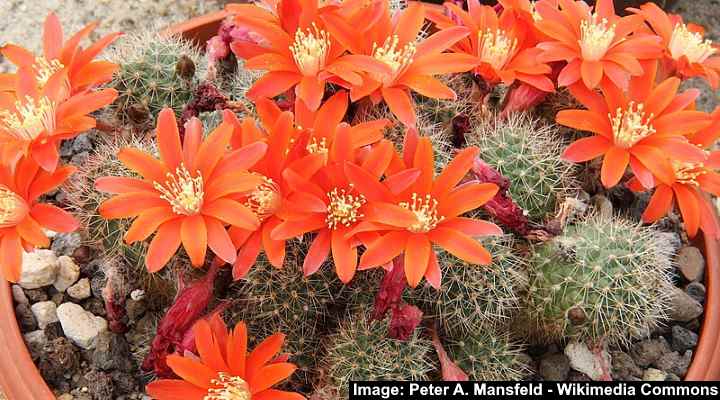
The orange crown cactus is an ornamental succulent native to South America. The small cactus has round, globular stems covered in clusters of small, elongated spines. These slender spikes range in color from white to yellow or reddish-brown. The cactus crowning glory is its beautiful orange daisy-like flowers that appear in spring and summer.
The stunning funnel-shaped cactus blooms measure 1.8” (4 cm) long and 1.6” (4 cm) in diameter—almost larger than the cactus. These flowers contrast beautifully against the spiny stems, attracting pollinators like bees and butterflies. The clustering cacti grow 2.4” (6 cm) in diameter and eventually form a large mound.
The crown cactus is a charming small plant suitable for a houseplant collection. It has the same care requirements as for most indoor cactus plants.
Peanut Cactus (Echinopsis chamaecereus)

The peanut cactus is a popular mat-forming cactus plant with green, finger-like stems. Ideal for growing indoors, the clumping cactus has stems 4” to 6” (10 – 15 cm) long with eight to ten ribs and rows of soft white bristles. The cactus blooms with reddish-orange funnel-shaped flowers in spring.
Native to Argentina, the cactus’s common name is from its stem’s shape, which resembles a peanut shell. Its trailing stems make it an ideal flowering cactus for a hanging basket. You can also grow it outdoors in frost-free climates for ground cover to decorate rock gardens or succulent gardens.
Pencil Cactus (Euphorbia tirucalli)

The pencil cactus is not a true cactus—it’s a succulent in the family Euphorbia. The plant’s characteristics are its pencil-like, slender, green stems, thick woody trunk, and clusters of golden yellow flowers. Growing outdoors in tropical climates, the succulent can grow 20 to 30 ft. (6 – 9 m).
The most common use for pencil cactus plants is as a houseplant, where it can grow 6 ft. (1.8 m) tall. Keeping the plant in a bright location is vital and provides minimal water. It’s good to note that the plant contains a milky sap that can cause skin irritation.
Thimble Cactus (Mammillaria gracilis var. ‘fragilis’)

The thimble cactus is a cute, cylinder-shaped cactus plant with eye-catching interwoven white spines. This cactus species forms mounding mats as it spreads along the ground in desert landscapes. The individual globular cacti grow 4” (10 cm) tall and 2” (5 cm) wide.
Due to their small size, clusters of thimble cacti are ideal houseplants. The cylindrical, green stems in a thimble shape grow in a spiral pattern. The woven spines give the green cacti a white, spiky appearance. In spring, it produces small pink, white, or yellow flowers.
Mistletoe Cactus (Rhipsalis baccifera)
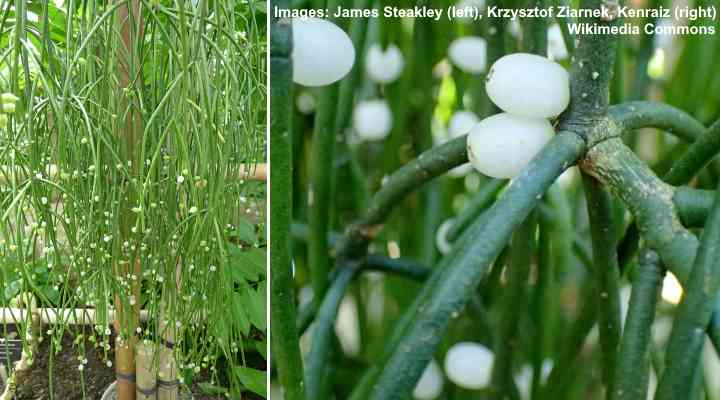
The mistletoe cactus is a type of epiphyte plant native to tropical rainforests. Characteristics of the succulent cactus are its long, hanging, pencil-thin stems, delicate white flowers dangling on thin stems, and small white ball-like fruits resembling small berries. The trailing cactus grows up to 6 ft. (1.8 m) long.
The mistletoe cactus stems are typically green but can also have a reddish or brownish hue. Due to its tropical nature, it’s a stunning houseplant for growing in hanging containers. It’s easy to grow indoors if it gets bright light, protected from direct sunlight.
Grama Grass Cactus (Sclerocactus papyracanthus)

The grama grass cactus is a small desert plant covered in masses of curly spines that hide its stem. Native to the deserts of southern North America, the unique cactus grows up to 3.14” (8 cm) tall and 1” (2.5 cm) wide. It’s characterized by its dense, papery spines, funnel-shaped white flowers, and dry, green fruit.
Grama grass cacti have multiple uses in desert landscapes. The grayish, tan, or white spines add texture to xeriscaping, rock gardens, or water-wise landscapes. Additionally, it creates a striking appearance when part of an indoor succulent garden.
Simpson Hedgehog Cactus (Pediocactus simpsonii)

The Simpson hedgehog cactus—mountain ball cactus or snowball cactus—is a small, spiky cactus with a round shape. This common succulent plant grows 10” (25 cm) and 6” (15 cm) wide. Its egg-shaped stem is covered in clusters of short, sharp, reddish spines, rosy-pink, white, or yellowish flowers, and round, cylindrical fruits.
The Simpson hedgehog cactus blooms in late spring or early summer, producing beautiful, cup-shaped flowers. A feature of the hedgehog cactus is its tolerance of freezing temperatures, making it suitable for rock gardens in northern climates. Because of its adaptability, it’s a suitable cactus for growing indoors.
Its native habitat is the mountain regions of western North America as far north as the Canadian border.
Turk’s Head (Ferocactus hamatacanthus)

Turk’s head is a type of barrel cactus popular for indoor succulent collections. The globular, heavily ribbed cactus plant grows up to 24” (60 cm) tall. It has 13 to 17 ribs, long, stiff spines 2” to 2.7” (5 to 7 cm) long, and large, showy yellow flowers.
After flowering, Turk’s head produces oval-shaped, edible, dark brown fruits 0.8” (2 cm) long. In its native habitat of the Chihuahuan Desert and southwestern Texas, the cactus grows in a large, oblong shape. However, indoors in full sunlight, it retains its globular appearance. It’s also a great addition to desert gardens, xeriscaping, or as a focal point.
Berlandier’s Hedgehog Cactus (Echinocereus berlandieri)

Berlandier’s hedgehog cactus is a small cactus growing in clumps of cylindrical dark green stems. Growing in Texas and northern Mexico, identifying features of the cactus are its cylinder-like stems up to 23” (60 cm) long, spines 2” (5 cm) long, and pinkish to reddish-purple flowers. The funnel-shaped flowers bloom in late spring and summer.
Berlandier’s hedgehog cactus prefers well-draining soil and full sun. It can tolerate drought and hot temperatures but performs poorly in humid conditions. The desert plant is a popular choice for rock gardens, succulent gardens, or as an indoor potted plant.
Outdoor Types of Cacti (With Pictures and Names) – Identification Guide
Planting different varieties of cacti outdoors is a great way to add exotic plants to your garden landscape.
In general, cacti are low-maintenance plants that can survive harsh conditions. However, for all types of cacti to thrive outdoors, they need slightly moist to dry soil. Too much water can result in their roots rotting.
Even if you have a small garden or a balcony, there are many varieties of small cacti that are great for growing in containers outside.
Let’s look at some popular cacti you can easily grow outdoors.
Arizona Barrel Cactus (Ferocactus wislizeni)
The Arizona Barrel cactus is a desert cactus variety that is native to the Sonoran Desert.
The Arizona Barrel is a large round spiky type of cactus that can grow to an impressive 6 ft. (1.3 m) in height and measure 2 ft. (60 cm) in diameter. Although the most common types grow between 3 and 4 ft. (0.9 – 1.2 m).
The olive-green skin of Arizona barrel cactus is covered in yellow hooked spines that grow on the ribs. This cactus species is drought-resistant and gets moisture from occasional flooding that takes place.
The Arizona Barrel cactus flowers in the middle of June and these blooms are a delightful reddish-orange color.
Having few of these Arizona cacti in your garden can create a stunning feature, especially when planted together in a grid formation.
Cactus Identification: The Arizona Barrel cactus is a type of ball cactus with stiff, sharp spines. Like many globe-shaped cacti, this round spiky cactus has a cylindrical shape with thick, leathery, prominent ridges. Red or yellow flowers appear as a colorful ring around the spiky, woolly top of the cactus when blooming in spring or summer.
Prickly Pear Cactus (Opuntia)

Prickly Pear cacti grow in areas that are prone to drought and produce purple or rose-colored flowers.
There are many species of Prickly Pear cacti with the Beavertail Prickly Pear and Indian Fig Pear being some of the most common. This outdoor cactus variety generally has large barbed spines up to 1 inch (2.5 cm) in length. These cactus spikes can easily puncture the skin. The spines also shed which means that this type of cactus may not be suitable for all gardens.
The cactus is formed by large flattened pad-like structures that are a light blue-green color.
There are various types of Prickly Pear cacti that can suit many landscaping needs. For example, the Beavertail cactus (Opuntia basilaris) can grow into a medium-sized shrub-like plant that is about 15” (40 cm) tall and produces pink flowers. However, the tall Indian Fig cactus (Opuntia ficus-indica) is a spineless variety of cactus that can grow up to 23 ft. (7 m)!
If you have cold winters and you want a prickly pear to decorate your garden, then try the Santa Rita prickly pear cactus. This can withstand temperatures as low as 15°F (-9°C) and grow to a height of 1.5 ft. (45 cm).
Cactus Identification: A Prickly Pear cactus is easy to identify due to its broad, flat pads covered in tufts of long white spines. Another trait of Prickly Pear cacti is their fine barbed hairs that can penetrate the skin, causing irritation.
Beavertail Cactus (Opuntia basilaris)
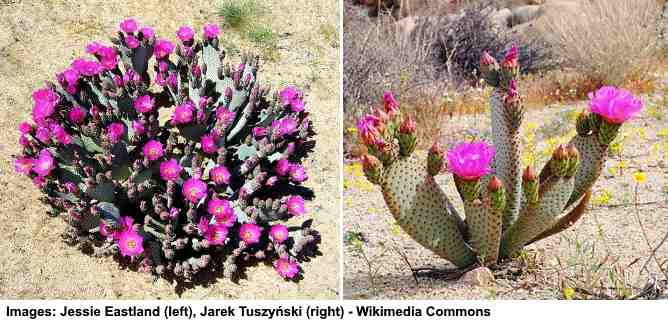
The beavertail cactus is an iconic desert plant in southeastern California and western Arizona. The low-spreading succulent plant has wide, flat pads with a purple tinge, gray-blue bristles, and vibrant rose-purple flowers that bloom in spring and early summer. This shrubby cactus grows 1 ft. (0.3 m) tall and 4 ft. (1.2 m) wide.
Distinctive features of the beavertail cactus are its pale greenish-gray pads, no long spines, and large, vibrant, rosy funnel-shaped flowers 3” (7.5 cm) wide. It blooms in summer. As its common name suggests, the flat, round pads are shaped like a beaver’s tail.
Beavertail cacti are a popular choice for desert gardens and xeriscape landscaping. They have low maintenance requirements and a unique appearance. Although the pads have clusters of small bristles, the lack of sharp spines makes it ideal for garden landscapes.
Indian Fig Cactus (Opuntia ficus-indica)

The Indian fig cactus is one of the most common prickly pear cacti grown for its delicious fruits. Like all cacti in the genus Opuntia, the Indian fig plant has thick, succulent, spatula-shaped pads covered in sharp spines, red, yellow, or white flowers, and red egg-shaped fruits. The large shrub-like cactus grows up to 23 ft. (7 m) tall.
The Indian fig cactus blooms in spring and summer, producing vibrant showy flowers. In addition to spiny cacti, several species of Indian fig cactus have spineless pads.
The cactus’s stems and fruit are also excellent food sources. Some studies suggest it has one of the highest vitamin C concentrations of any fruit. The prickly pear fruits make delicious jams and jellies. Additionally, the young stems can be fried and served with eggs. Its spineless pads are also an important fodder source for cattle.
Saguaro Cactus (Carnegiea gigantea)
One type of very tall Arizona cactus is the Saguaro cactus, which can grow over 40 ft. (12 m) tall. However, it is a slow grower and may take more than 100 years to reach its full height. You can identify this desert cactus by its classic “cactus” appearance. The Saguaro cactus has a tall, long central body and “arms” that reach up to the sky.”
This type of columnar cactus is a common sight in deserts in Mexico, Arizona, and California. Some species of the Saguaro cacti grow arm-like structures, whereas others are just like a tall column. The ribs that run up the length of this tall cactus variety have lots of sharp hard spines.
Similar to other cacti species, the Saguaro cactus is a flowering plant. White flowers appear on the giant cactus in late spring to early summer. After flowering, red edible fruits appear that have a sweet fleshy texture.
Even though this cactus grows to an enormous height outdoors, you can actually grow this cactus species indoors in a container. Due to its slow growth rate, the Saguaro cactus may only grow an inch (2.5 cm) in height in a 10-year period!
Cactus Identification: The Saguaro cactus is easy to identify due to its columnar growth with arm-like, arching stems. This tall upright desert plant has vertical spiky ribs, giving the cactus columns a ribbed appearance.
Queen of the Night (Epiphyllum oxypetalum)
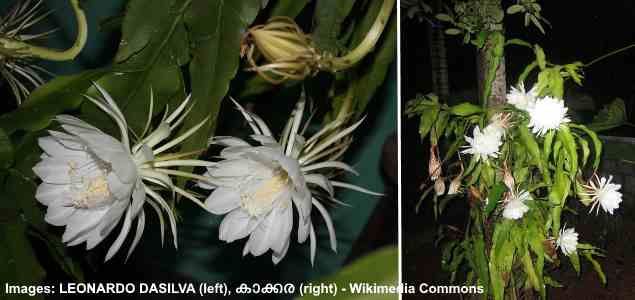
The Queen of the Night is a type of orchid cactus because of the beautiful flowers which resemble some orchid species
The Queen of the Night (name: Epiphyllum oxypetalum) cactus gets its name from the fact that its beautiful white flowers only bloom at night. This orchid-type cactus is also called the Dutchman’s Pipe cactus.
Originating in Southern Mexico and South America, the queen of the night is a flowering type of cactus that has long cylindrical ribbed columns. Some of these cactus stems can grow to a height of 20 ft. (6 m). From the main green stem, smaller stems branch off that produce white flowers that give off a pleasant fragrance.
One of the reasons why this type of cactus is prized is due to its large flowers. The flowers from the Queen of the Night can be up to 11” (28 cm) long and 5” (13 cm) wide. This type of flowering cactus only blooms at night when the temperature drops to between 52 and 57°F (11 – 14°C).
Being a type of tropical cactus, Queen of the Night cacti enjoy indirect sunlight throughout the day. If you live in colder climates, it is best to grow this type of cactus as an indoor houseplant.
Cactus Identification: The Queen of the Night is identified by its spectacular white flowers that bloom once a year at nighttime. The Queen of the Night cactus has identifiable flattened long trailing stems with wavy margins.
The Old Man Cactus (Cephalocereus senilis)
Another tall columnar variety of cactus is the Old Man Cactus (name: Cephalocereus senilis) which is covered with a “woolly” white coat.
Planting the tall columnar Old Man cactus creates an interesting feature in any garden. The stems can grow in clusters and reach a height of between 16 and 52 ft. (5 – 15 m). Due to the unkempt appearance of the shaggy white hair covering the tubular cactus plant, it is called the ‘Old Man’ cactus.
When planted outdoors, you may have to wait for at least 10 years for the Old Man cactus to flower. By this time, it may have lost some of its distinctive white woolly coat but will produce yellow, red, or white flowers.
Even though the tall cactus looks like it is covered by soft cotton, sharp hard spines grow beneath the hairy exterior. For best results, plant the Old Man cactus where it gets plenty of sun and in well-drained soil.
Cactus Identification: The Old Man cactus is easy to identify due to its cylinder shape and easily distinguishable white fuzzy appearance.
Strawberry Cactus (Echinocereus enneacanthus)
If you live in a hot dry climate, then the Strawberry cactus can be a great addition to your garden landscape.
The Strawberry cactus is a type of blooming cactus that grows in clumps of small spiky cactus stems. This is one reason why this cactus species is also called the Hedgehog cactus. Each cluster of cactus stems can contain around 20 balls.
The Strawberry cactus is an outdoor desert cactus that blooms around late spring and produces stunning magenta flowers. The funnel-type desert flowers have deep pink petals with a black and yellow center. These cactus flowers can grow up to 3.5” (9 cm) long.
The sharp spines on the Strawberry cactus can also add a bit of color to your garden. These inch-long (2 cm) spines can come in various colors such as yellow, brown, white, and gray.
Cactus Identification: The Strawberry cactus is a desert plant, identified by its ribbed columnar spiky stems, stunning magenta flowers, and reddish-purple edible fruit.
Starfish Cactus (Stapelia grandiflora)
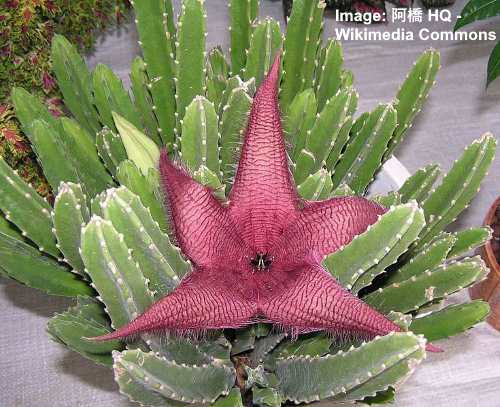
The colorful flower of the Starfish cactus is large and can be up to 10″ (25 cm) in diameter
A Starfish cactus is a type of succulent with long, erect four-sided columnar stems that have white dots along the margins. The outstanding feature of starfish cacti is their large reddish-purple star-shaped flowers. The starfish flower is also called the carrion flower, and the pointed blooms give off a powerful stench.
Starfish cactus has various species with many hybrids, and although called a cactus, the Starfish cactus is a type of succulent. The ribbed, upward pointed fleshy pale-green columns grow up to 12” (30 cm) tall.
The large, showy starfish-shaped flowers are orange, deep red, or reddish-purple and grow up to 6” (15 cm) across and appear on the clumping succulent plant in late summer and the fall. The hairy red flowers attract insects.
Cactus identification: The Starfish cactus is identified by its tufted erect pale-green quadrangular stems with upward-pointing hooks on the edges and reddish-scarlet large star shaped flower.
Brazilian Prickly Pear (Brasiliopuntia brasiliensis)
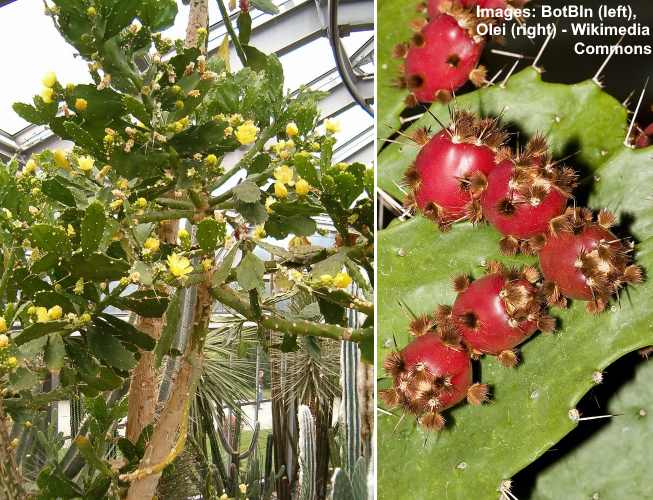
The flowers of the Brazilian Prickly Pear cactus (left) develop into edible juicy fruits
The Brazilian Prickly Pear has characteristic flat rounded pads and flowers, which is a trait of many prickly pear cacti. The unusual feature of this ornamental cactus plant is its tree-like growth with bright green flat stems growing from a central round cylindrical stem. The cactus plant can grow up to 30 ft. (9 m) tall.
Pictures of the cactus leaves show small spines growing on the “leaf” margins. First, the showy cactus blossoms are yellow to bright orange. Then, they develop into red, yellow, purple, or orange pear-like edible fruits with a fragrant aroma and juicy texture.
Cactus identification: The Brazilian Prickly Pear is identified by its slender, firm, rounded pole-like stem that produces green oval, flattened spiny segments that appear like leaves.
San Pedro Cactus (Echinopsis pachanoi)
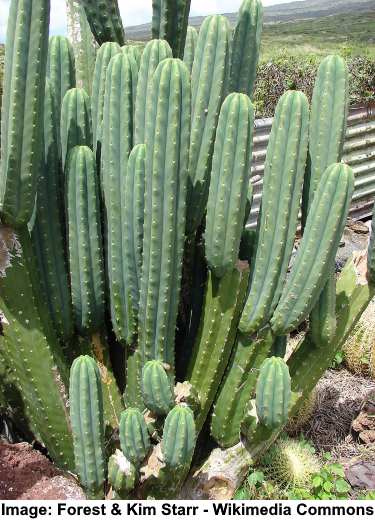
The tall San Pedro cactus has columnar stems and large white flowers
The San Pedro cactus is a fast-growing columnar pale green cactus with vertical ridges along its length dotted with white areoles. The clump-forming cactus stems can grow up to 10 – 20 ft. (3 – 6 m) tall and up to 6” (15 cm) in diameter. Large fragrant white flowers, 9” (23 cm) long bloom during the night.
The San Pedro cactus grows well as a houseplant in pots that restrict its growth or outdoors in zones 8 – 10. The white areoles dotted along the pronounced ridges contain numerous sharp spines. The cross-section of the cactus stems shows it has a star shape with rounded tips.
Cactus identification: The San Pedro cactus is identified by ribbed columnar stems, tufts of jaggy spikes, and large aromatic white flowers.
Walkingstick Cactus (Cylindropuntia spinosior)
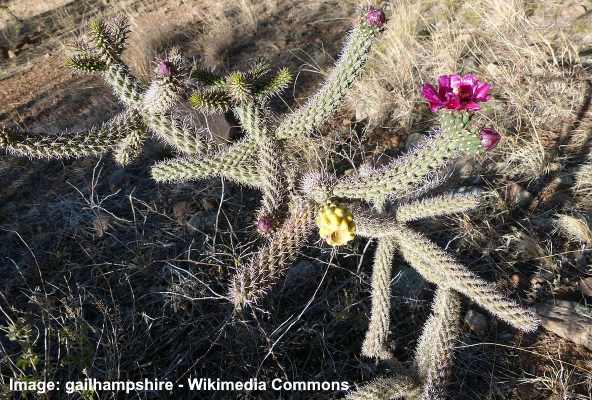
Walkingstick Cactus has yellow bumpy fruit and purple-magenta flowers
The Walkingstick cactus, a unique member of the Cholla Cactus family, thrives in desert environments with its slender, sharply spiny stems. The unusual cactus has a branching growth with thick stems growing at right angles from the main stem. From a distance, the branching cactus has a fuzzy appearance. The Walkingstick cactus grows up to 4 ft. (1.2 m) tall.
Also called the cane cholla or spiny cholla, this cactus species is characterized by deep purple-magenta flowers blooming in summer. These are followed by spineless yellow fruit that have a knobby appearance.
Cactus identification: The Walkingstick cactus is identified by its branching growth with stems growing evenly at right angles and measuring 2” to 20” (5 – 50 cm) long.
Old Man of the Mountain Cactus (Oreocereus trollii)
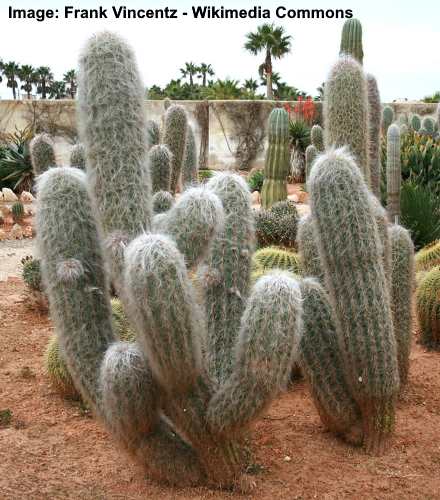
The Old Man of the Mountain Cactus has a tall columnar fuzzy look
The Old Man of the Mountain Cactus is a columnar succulent plant covered in abundant white hairs. The slow-growing cactus has long, stiff red spines that poke out the fine white hair. Despite being a tall cactus that grows in clumps in its native South America, the columnar white and spiky red cactus thrives in pots indoors.
Also called the Old Man of the Andes, this woolly cactus grows up to 2 ft. (0.6 m) tall outdoors. However, when growing indoors in small pots, the pot size restricts its size and growth.
Cactus identification: To identify the Old Man of the Mountain, look for a columnar cactus covered with white woolly fur and long, dangerous red spikes.
Rickrack Cactus (Selenicereus anthonyanus)

Rickrack cactus—also called the fishbone cactus or zig-zag cactus—is distinctive due to its leaf-like stems. Its unique flat, notched stems have a zig-zag or rickrack pattern. The succulent ornamental cactus blooms at night with fragrant white or pink spiky flowers that last a single night.
Native to southern Mexico, the rickrack cactus has trailing stems growing up to 3 ft. (0.9 m) long and 6” (15 cm) wide. Its large, showy pink flowers measure 6.7” (17 cm) in diameter and 4.7” (12 cm) long. After flowering, oval or round fruits appear measuring 2.3” (6 cm) in diameter.
The rickrack cactus is an epiphytic cactus that gets nutrients from the surrounding environment. It’s ideal as a trailing houseplant for hanging baskets if kept in a bright location and consistently warm temperatures.
Jumping Cholla Cactus (Cylindropuntia fulgida)

The jumping cholla cactus is a unique desert cactus native to Sonora and the Southwestern U.S. The cactus is identified by its tree-like growth with drooping spiny branches. The spine-covered stems are light green and produce branches of chained fruit. It blooms mid-summer with white and pink flowers 1” (2.5 cm) wide.
Jumping cacti are easy to spot in the desert. They have segmented stems and cylindrical shapes, giving the plant a distinctive appearance. Its name comes from the tiny barbs covering cholla spines. These easily “jump,” sticking onto anything that comes into the slightest contact with it.
The large jumping cactus grows up to 13 ft. (4 m) tall. Its range extends through the Colorado Desert, Sonoran Desert, and the Mojave Desert. It’s also called the hanging chain cholla, chain fruit cholla, and cholla brincadora.
Organ Pipe Cactus (Lemaireocereus thurberi / Stenocereus thurberi)

Organ pipe cactus is a striking, iconic cactus native to the Sonoran Desert. Its unique branching shape is from cylindrical, vertical stems rising from a single trunk. The pipe-like stems grow up to 16 ft. (5 m) tall and 12 ft. (3.5 m) wide. Some species are reported to be as tall as 26 ft. (8 m).
The upright spiky stems measure 6” (15 cm) thick and have up to 19 ribs. The desert cactus blooms with eye-catching white, funnel-like flowers during late spring and early summer. The flowers only bloom at night. After flowering, large fruit appears. These are tennis ball-sized with red flesh and taste like watermelon.
It’s important to note that the organ pipe cactus is a protected species. Southern Arizona is the only place in the U.S. where it grows, and it is located in a UNESCO reserve called the Organ Pipe Cactus National Monument.
Teddy Bear Cholla (Cylindropuntia bigelovii)
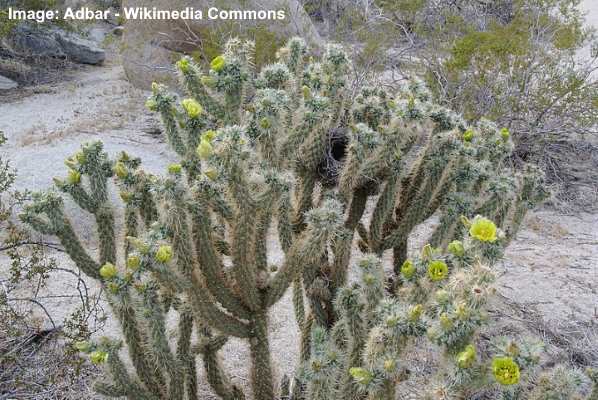
The Teddy Bear Cholla is a spectacular desert cactus native to the American Southwest. Its eye-catching appearance stems from its fuzzy, stubby branches that grow in an irregular pattern on short trunks. From a distance, it resembles a furry teddy bear. However, it is covered in sharp golden spines that can easily detach and adhere to the skin.
The teddy bear cholla grows 3 to 8 ft. (0.9 to 2.4 m) tall and wide. Its silvery-white spines give it a bright appearance. With age, the trunk darkens in contrast to the light green stems. It blooms in spring and summer with greenish-yellow flowers.
It’s adapted to desert environments, tolerating drought, full sun, and high temperatures. Due to the sharp, barbed spines, it’s best to admire it from a distance and avoid touching it.
Arizona Pencil Cholla (Cylindropuntia arbuscula)
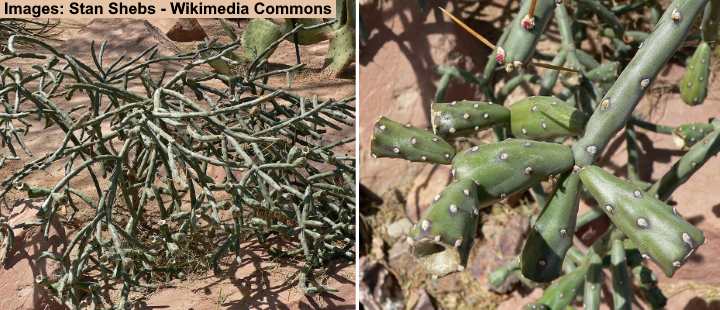
Arizona pencil cholla is a unique and striking desert plant native to Arizona. The shrubby cactus features slender, cylindrical stems covered in numerous spines 1.5” (4 cm) long. The segmented stems form a vase shape on a short trunk. Mature cacti can grow 7 ft. (2.1 m) tall with hundreds of stumpy branches.
The light green stems sometimes have a purple tinge. The pencil cholla blooms in early summer with cup-shaped bright yellow to bronze, sometimes red, flowers. These give way to spineless green fruits that mature to yellow. This drought-tolerant, hardy cactus thrives in full sun and well-draining soil. It’s a popular cactus species for xeriscaping.
Hoffmann’s Teddybear Cholla (Cylindropuntia fosbergii)

Hoffmann’s teddybear cholla is an eye-catching desert cactus plant endemic to Southeastern California. Unique characteristics of this cacti species are its pinkish spines on short, segmented stems, giving it a furry appearance. However, the spines are exceedingly sharp. This small cactus typically grows up to 3 ft. (0.9 m) tall and 4 ft. (1.2 m) wide.
Tree Cholla (Cylindropuntia imbricata)
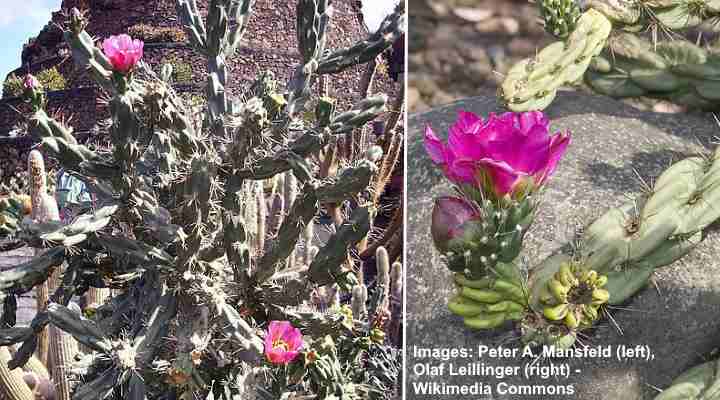
Tree cholla—also called walking stick cholla, cane cactus, and devil’s rope pear—is a densely branched shrub-like cactus. It features a strong central trunk with gray-green, rope-like cylindrical stems. These are covered in brown, silver, or pink needle-like spines. It blooms in spring and summer with purple or pink bowl-shaped flowers.
This spiky cactus species is native to the Southwestern United States. It grows 3 to 8 ft. (0.9 – 2.4 m) tall and wide. Its flowers are 3” (7.5 cm) across, and its yellow fruits remain on the plant for months. It forms a dense cluster of short stems—typical of cholla cacti. It’s drought-tolerant and used for desert gardens, rock gardens, or xeriscaping.
California Cholla (Cylindropuntia californica)

California cholla—also called snake cholla—is a type of cactus with elongated cylindrical stems covered in short yellow to orange-brown spines. The short, sprawling cactus blooms yellow-green to yellow flowers, followed by leathery fruit. The desert plant is found in Baja California, Arizona, and southern San Diego.
This California cholla blooms in spring and summer, producing showy pale yellow to greenish-white flowers with red tips. The multi-trunked cactus typically grows up to 5 ft. (1.5 m) tall, and its robust, ribbed stem segments are less than 10” (25 cm) long.
Staghorn Cholla (Cylindropuntia versicolor)

The staghorn cholla is a visually striking cactus with unusual purple and green stems. Growing up to 6 ft. (1.8 m) tall, the shrub-like cactus blooms in spring, producing striking magenta, yellow or red flowers at the stem tips. While the stubby stems are covered in spines, they are not as numerous as other cholla species.
The purple-colored cactus plant also produces spineless fruits. These are pear or barrel-shaped, measuring up to 2” (5 cm) long. Staghorn cholla cacti are native to the Southwestern United States and northern Mexico. It’s found in desert scrub and rocky areas. It’s similar in appearance to the buckhorn cholla and pencil cholla.
Additionally, this drought-tolerant plant can withstand hot, arid conditions. It’s often used in xeriscaping designs and desert garden landscapes.
Golden Snake Cactus (Bergerocactus emoryi)
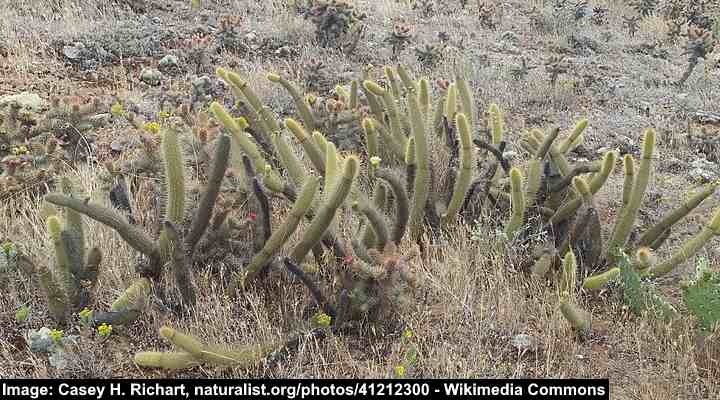
The golden snake cactus is a columnar cactus plant that forms thickets in southwestern deserts in the U.S. The thick, cylindrical stems grow 6.5 ft. (2 m) tall and covered in yellowish needle-like spikes in dense clusters. The cactus blooms with yellow flowers measuring up to 2” (5 cm) long.
Other names for the desert cactus are velvet cactus, golden spined cereus, and golden club cactus. From a distance, the columnar stems have a velvety appearance due to the golden color of the spines. Reddish, globular fruits appear after the yellow flowers bloom and are covered in dense spines.
Senita Cactus (Pachycereus schottii)
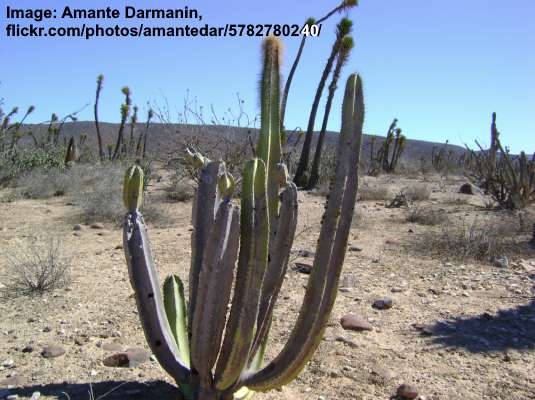
The senita cactus is a picturesque desert plant characterized by upright gray-green stems growing in clumps. The slow-growing columnar cactus grows up to 13 ft. (4 m) tall and 6” (15 cm) in diameter. In time, the columnar stems develop a dense covering of white, hair-like spines resembling an old man’s beard, hence its other common name – the old man cactus.
The flowering cactus blooms at night with funnel-shaped pinkish-white flowers. Its funnel flowers measure 1.8” (4.5 cm) long and 1.2” (3 cm) in diameter. Its cylindrical, ribbed stems also produce reddish egg-shaped fruits when mature.
The senita cactus thrives in harsh desert conditions in Arizona and Northwest Mexico. Identifying features of this clump-forming cactus are its highly bristled stem tips and distinctive ribbed appearance.
Violet Prickly Pear (Opuntia gosseliniana)
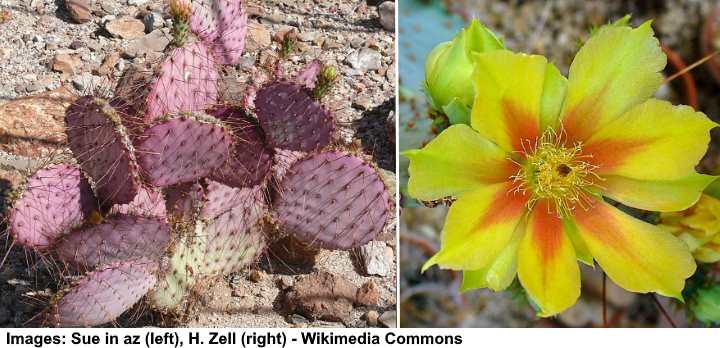
The violet prickly pear is one of the most unusual desert plants with flattened round stems. The round pads have a pink, violet, or red tinge and are covered in short, stumpy spikes and glochids—tiny hair-like structures that get easily stuck in the skin. The colorful cactus grows up to 5 ft. (1.5 m) tall.
Violet prickly pears are found in the Sonoran desert and Arizona. It blooms in late spring and early summer, producing beautiful yellow flowers with reddish-orange centers. These flowers are followed by edible, prickly pear fruits, which ripen from green to purple.
The violet prickly pear is drought-tolerant and can withstand extreme temperatures and intense sunlight. You can also plant it in desert garden landscapes or xeriscaping gardens to add vibrant color to an arid environment.
Golden Barrel Cactus (Echinocactus grusonii)
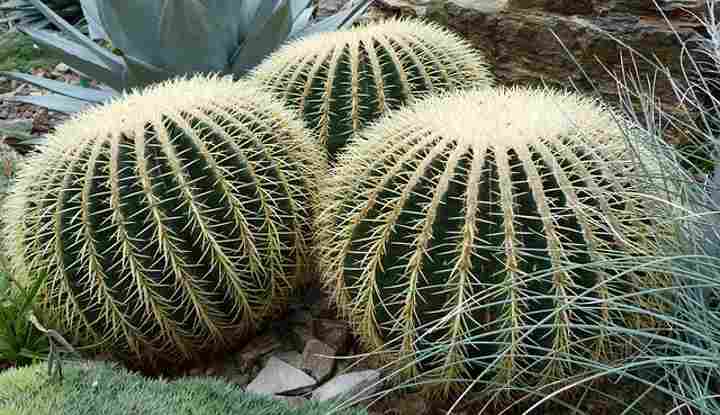
The golden barrel cactus is an easily recognizable desert plant due to its green ball shape, prominent ribs, and stiff yellowish spines. The barrel-shaped cactus blooms in late spring and summer with bright yellow flowers. It has slow growth, eventually reaching 2 ft. (0.6 m) tall.
Native to the Southwestern U.S., the spherical cactus forms clumps up to 6 ft. (1.8 m) wide, giving it an oblong shape. In USDA zones 9 to 12, it’s also a popular landscaping desert plant. Its large, spiky ball looks great in rock gardens, desert gardens, or ornamental containers.
However, its sharp, stiff spines make it important to handle it with care and keep it out of reach of children and pets.
Hedge Cactus (Cereus hildmannianus)

The hedge cactus—also called Andes organ pipe—is an impressive cactus species with clusters of upright, ribbed, columnar stems. The blue-green stems have four to six ribs and bloom with white or yellowish-white fragrant flowers from late spring through fall. The flowers are followed by red or orange egg-shaped fruits.
The hedge cactus grows up to 50 ft. (15 m) tall in its native South America. Although it sometimes has needle-like spines, most varieties are spineless. This makes them a popular landscaping choice in arid, desert conditions. It’s also a night-blooming cactus, and the showy flowers remain for one day.
Spinystar Cactus (Escobaria vivipara)
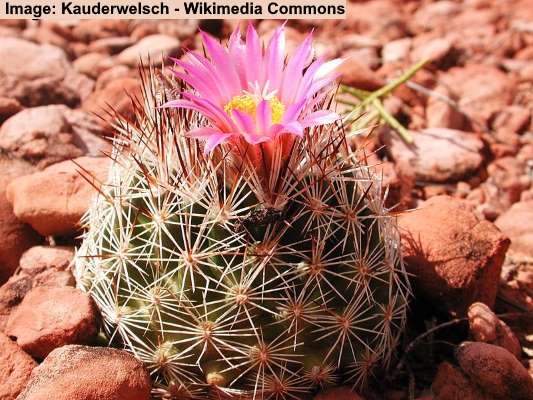
The spinystar cactus is a small, resilient, clump-forming desert plant with a spherical shape and spiny texture. This small cactus species doesn’t grow taller than 6” (15 cm) tall and spreads in a clumping habit. The cactus blooms in spring with red, pink, yellow, or purple cup-shaped, daisy-like flowers.
Its common name—spinystar cactus—refers to the appearance of this desert cactus. It has star-shaped clusters of white spines. Other names for this cactus are ball cactus, pincushion, cactus, and viviparous foxtail cactus. The term ‘viviparous’ refers to its spreading nature by producing pups from its stem’s base.
Mexican Fencepost Cactus (Lophocereus marginatus)
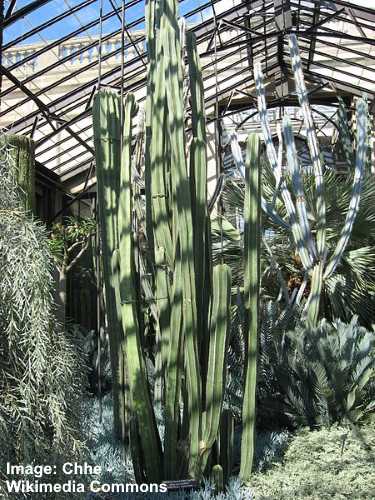
The Mexican fencepost cactus is an outstanding, tall, columnar desert plant with straight, upright stems—like a fencepost. The dark green clumping stems grow from the base, each reaching up to 15 ft. (4.5 m) or taller. The stems have five to seven ribs and bloom in spring with pinkish flowers followed by spiny red fruits.
With its exceptionally straight, unbranched stems, the Mexican fencepost cactus makes a visual impact in desert landscapes. The low-maintenance, drought-tolerant plant is useful as a windbreak, accent, specimen plant, or succulent hedge. It tolerates extreme heat and brief frost periods down to 24°F (-4°C).
Key Tree Cactus (Pilosocereus robinii)

The key tree cactus is native to the Florida Keys and is characterized by its spreading, segmented green branches. The tall tree cactus grows up to 33 ft. (10 m) tall. Identifying features are its ribbed, columnar stems, short spines, and greenish-white bell-shaped flowers that smell like garlic.
Due to habitat loss, the key tree cactus is a rare, endangered species.
Greater Antillean Tree Cactus (Pilocereus polygonus)

The greater Antillean tree cactus is a multi-stemmed cactus species native to the southeastern United States. The jagged cactus is characterized by tall, columnar stems with up to 13 pronounced ridges. These have clusters of large radiating stiff white spines. The unusual cactus blooms with large funnel-shaped white flowers.
The greater Antillean tree cactus grows up to 23 ft. (7 m) or more. The stems are ribbed and covered in rows of sharp spines, making the cactus unsuitable for garden landscaping.
The greater Antillean tree cactus is adapted to arid and rocky habitats and is often found growing in coastal areas. It is highly drought-tolerant and can survive in harsh conditions.
Royen’s Tree Cactus (Pilosocereus royenii)

Royen’s tree cactus—also called Royen’s pipe organ cactus—is a tall and columnar cactus. Identifying features of the cactus are its tubular-shaped branches with vertical ribs and sharp spines. It has a distinctive appearance, with multiple grayish-green branches growing from a central trunk. It grows 6.5 to 26 ft. (2 – 8 m) tall.
The stem is covered in grayish-green, vertical ridges that resemble pipes on an organ, hence its name. The impressive tree-like cactus plant blooms with small pink or white flowers and edible, reddish-purple fruits.
Night Blooming Cereus (Peniocereus greggii)

Night-blooming cereus produces stunning white flowers measuring 12” (30 cm) in diameter. The showy flowers bloom for one night in the year. They have pure white petals and have a strong vanilla scent. Other characteristics of this unique cactus are its long, trailing, slender stems with ribbed, spiny segments and reddish fruit.
Apart from the spectacular blooming night in June or July, the cactus is a relatively unimpressive specimen. Its thin, dark grayish-green stems appear dead for most of the year. The exotic cactus grows up to 5 ft. (1.5 m) tall and 6 to 10 ft. (1.8 – 3 m) wide.
An interesting fact about the cactus is that all Peniocereus greggii bloom on the same night in a given area.
Spanish Stenocereus (Stenocereus fimbriatus)

The Spanish stenocereus is a type of columnar cactus known as the fringed organ pipe cactus. The features of the upright desert plant are its triangular ribs running vertically on the stems, clusters of white, stiff spines, and round, red fruits. The spiny plant can grow to 20 ft. (6 m) tall.
The evergreen cactus is a useful landscaping plant for subtropical and tropical climates, like its native Caribbean. Its sharp, spiky blue-green stems create an effective security fence or barrier. Its upright, columnar growth also adds a striking element to garden landscapes.
Hedgehog Cactus (Echinocereus chisoensis)
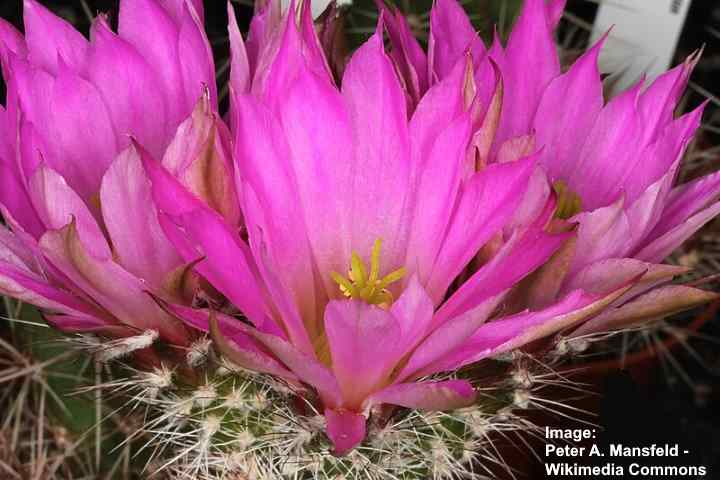
Echinocereus chisoensis var. fobeanus
The hedgehog cactus is a small and charming desert plant native to the Chihuahuan Desert in Texas. The spiky stems grow up to 12” (30 cm) long and bloom with vibrant pink flowers 4” (10 cm) long. Its pink flowers have whitish throats with purple or red near the base.
The hedgehog cactus has a spherical or cylindrical shape. Growing in arid conditions outdoors, it forms loose clumps in desert scrubland and rocky soils. Its spectacular pink flowers have made it popular with cactus collectors, which has put the rare cactus under threat of extinction.
Foxtail Cactus (Coryphantha alversonii)

The foxtail cactus is a barrel-shaped spiky cactus found growing in the Joshua Tree National Park and Mojave desert. The identifying feature of the plant is its clusters of black and white spines covering the small, rounded, or cylindrical stems. It blooms with attractive pink flowers at the ends of stems.
The common name of Coryphantha alversonii comes from its resemblance to a fox’s tail. It grows up to 10” (25 cm) tall and forms small clumps as it reproduces through offsets or pups. Bloom time is spring when yellow or pink flowers decorate the desert landscape.
Pima Pineapple (Coryphantha robustispina)
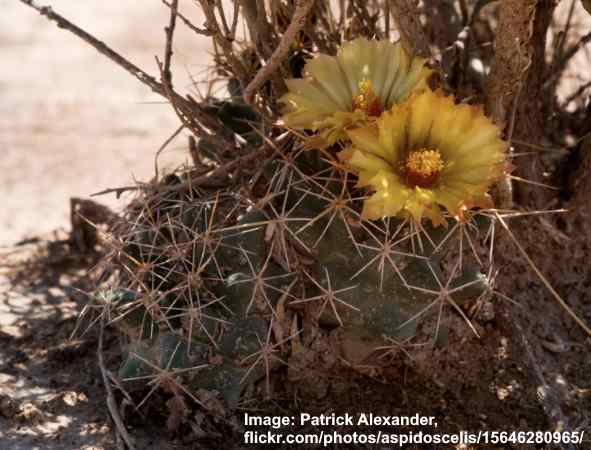
The Pima pineapple cactus is a protected cactus species native to the Sonoran Desert. The unusual green cactus has a pineapple-like appearance thanks to its protruding tubercles. The small egg-shaped plant grows up to 4” (10 cm) tall and grows solitary or in groups. Its ovoid stems have clusters of four spines per cluster.
Identifying features of the small, heat-tolerant cactus are its hooked, whitish spines with gray tips, golden yellow or pale yellow funnel-shaped flowers, and small cylindrical seed pods.
This small cactus is popular for indoor cactus and succulent collections. However, due to its rarity, it can be difficult to find in garden stores and specialist shops.
Hudson Pear (Cylindropuntia rosea)

The Hudson pear is a thorny, shrub-like cactus with short stems. The multi-branched desert plant has long, white, stiff spikes covering the segmented stems. It blooms in late spring and summer with showy rose-colored purple to pink flowers up to 2” (5 cm) wide.
Native to the Sonoran Desert in Arizona, the Hudson pear cactus has a shrubby appearance and grows 5 ft. (1.5 m) tall and 10 ft. (3 m) wide. Its botanical name comes from the reddish-pink blossoms growing on green to gray-green stems. Its stem can grow up to 3 ft. (0.9 m) long.
The clusters of white spines with reddish tips give the cactus a fuzzy appearance. However, its sharp thorns can be dangerous as they can easily puncture the skin.
Arizona Claret-Cup Cactus (Echinocereus arizonicus)

The Arizona claret-cup cactus is a small, spiny cactus found in the desert regions of Arizona. This beautiful desert plant is prized for its eye-catching orange to red blooms with yellow centers. The showy-cup-shaped flowers appear in April and May on small spike-covered short stems.
The native Arizona cactus is a small, clumping cactus growing up to 15” (38 cm). It has thick, cylindrical stems, each having up to 13 ribs. The small size of the Arizona claret-cup cactus makes it ideal for landscaping desert gardens, rock gardens, or growing in indoor containers.
Dahlia Hedgehog Cactus (Echinocereus poselgeri)

Native to southern Texas, the dahlia hedgehog cactus is a shrubby desert plant with slender cylindrical stems. The gray-green stems grow erect, develop a sprawling habit, and mature at 4 ft. (1.2 m) long. The cactus’s crowning glory is its cup-shaped rose-pink to pink-purple blossoms that appear in late spring.
Like many species of desert cactus, the dahlia cactus is covered in stiff spines, typically with eight to 16 spines in an areole. After blooming mid-summer, the cactus produces dark green to brownish fruits measuring 1.18” (3 cm) long.
The cactus commonly grows in rocky or sandy areas, and it is often used in desert gardens or xeriscaping and makes a striking addition to desert gardens.
Traveler’s Friend (Ferocactus emoryi)

Also called Emory’s barrel cactus, the traveler’s friend is a unique desert plant with an oblong to rounded shape. Identifying features of the cactus are its barrel-shaped body covered with pronounced ribs, prominent, thick white to reddish spines, and a crown of vibrant orange to brilliant red ray flowers.
This barrel cactus grows up to 2 to 8 ft. (0.6 to 2.5 m) tall and up to 3 ft. (0.9 m) wide. Like many single-stemmed barrel cacti, the traveler’s friend performs well in indoor containers. It also grows outdoors in USDA Zones 9 to 11 in hot, arid conditions with little water.
The common name of the cactus comes from its ability to store water. It’s said that travelers in the desert can drink the liquid in the cactus. However, the watery liquid is too alkaline to drink and can lead to dehydration.
Long-Spined Purplish Prickly Pear (Opuntia macrocentra)

The purple prickly pear is a stunning desert cactus with large, flat pads with a reddish-purple cover. As its name suggests, the identifying features of the shrubby cactus are its purple color and exceedingly long spines, up to 5” (13 cm) long. The purple color becomes more intense in cold or drought conditions.
Long-spined purplish prickly pear grows 3.3 ft. (1 m) tall, and its round pads are up to 8” (20 cm) in diameter. The long spikes emerge from dark purple to black areolas. It’s native to Texas, Arizona, and New Mexico.
Purple prickly pear cacti bloom with bright yellow flowers in spring and summer. The showy daisy-like flowers measure up to 3.2” (8 cm) long. These are followed by egg-shaped to barrel-shaped spineless purplish fruits 1.6” (4 cm) long.
Marble Canyon Cactus (Pediocactus bradyi)
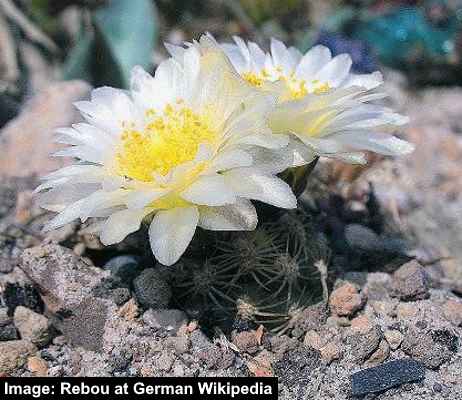
Also known as Brady’s pincushion cactus, this rare species features a globe-like shape with white and yellow flowers, complemented by a subtly woolly exterior. Distinguished by its blue-green hue and textured surface, the small, round cactus showcases white blooms with yellow centers and bears tiny reddish-brown fruits. It reaches a modest height of about 2.3 inches (6 cm) and spans 2 inches (5 cm) in width.
Due to its limited distribution and habitat loss, the Marble Canyon cactus is protected by law. Therefore, you cannot pick it if you come across it in Arizona deserts, where the cactus is endemic.
How to Grow Cacti Plants Indoors
Just how easy is it to care for indoor cactus breeds? It is surprisingly easy to look after different types of indoor cactus houseplants.
Most types of cacti that you can buy in garden centers and stores are well-suited for growing indoors. For your cactus plant to thrive, you should place it on a south-facing window sill where it gets plenty of sunshine.
One of the most important things to remember when caring for indoor cactus plants is to water them properly. Generally, cacti only need regular watering during the growing season when it is very sunny. You should water them well but allow all the excess water to drain out. During the fall and winter indoor cacti only need light watering every few weeks.
During the growing season, the ideal room temperature for cacti to grow well is around 70°F to 75°F (21°C to 23°C) during the day and 60°F (15.5°C) at night. (1)
Use soil and fertilizer that is prepared specially for indoor types of cacti.
How to Care for Outdoor Cactus Types
Cacti are excellent landscaping solutions for many types of gardens that get a lot of sun and heat during the summer.
Depending on where you live, you can also find types of cactus plants that can survive freezing temperatures in the winter.
When deciding where to plant your cactus outdoors, choose a location where water drains freely. For example, planting on the top of a rock garden or on a south-facing slope will ensure that the cactus doesn’t get waterlogged.
Related articles:
- How Often to Water Cactus Plants
- The Best Potting Soil Mix for Cactus Plants
- Cactus Care Guide: Watering, Sunlight, Soil and More

